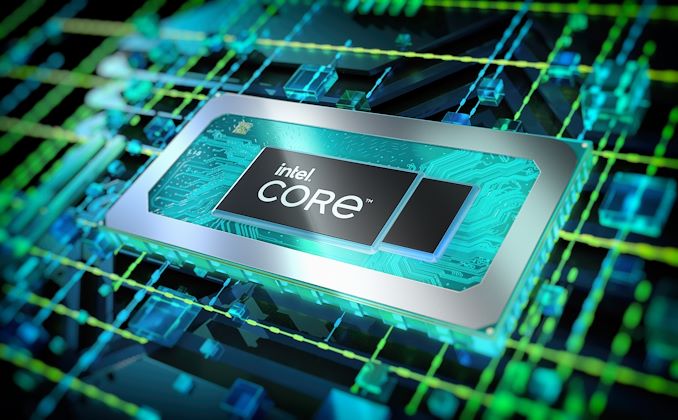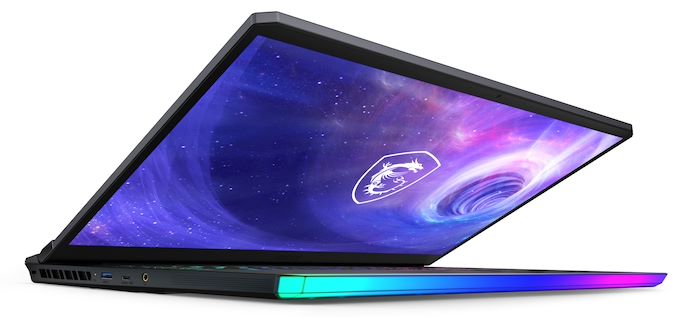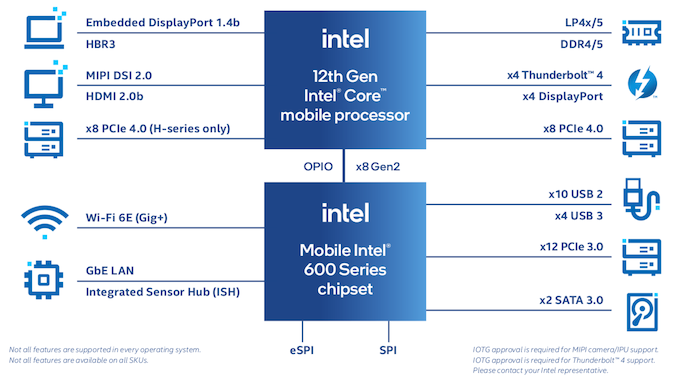Intel Alder Lake-H Core i9-12900HK Review: MSI's Raider GE76 Goes Hybrid
by Brett Howse on January 25, 2022 9:00 AM EST- Posted in
- CPUs
- Intel
- MSI
- Laptops
- Alder Lake
- GE76 Raider
- 12th Gen Core
- Alder Lake-H
_photo02_cr_678x452.jpg)
At CES this year, Intel officially announced its expanded Alder Lake processor lineup, including the performance-laptop focused H-Series chips, which traditionally fit in the 45-Watt range. For the last several processor generations, Intel has started their roll-outs with the low-power laptop parts, and then expanded the range up to and including desktop processors; but for Alder Lake they have flipped this on its head. Instead, Intel first launched desktop processors, such as the Core i9-12900K, and then moved down the range, with the performance notebook processors coming second, and the low-power processors coming later.
| Intel 12th Gen Core Alder Lake-H | |||||||
| AnandTech | Cores P+E |
E-Core Base |
E-Core Turbo |
P-Core Base |
P-Core Turbo |
Base W |
Turbo W |
| i9-12900HK | 6+8 | 1800 | 3800 | 2500 | 5000 | 45 | 115 |
| i9-12900H | 6+8 | 1800 | 3800 | 2500 | 5000 | 45 | 115 |
| i7-12800H | 6+8 | 1800 | 3700 | 2400 | 4800 | 45 | 115 |
| i7-12700H | 6+8 | 1700 | 3500 | 2300 | 4700 | 45 | 115 |
| i7-12650H | 6+4 | 1700 | 3500 | 2300 | 4700 | 45 | 115 |
| i5-12600H | 4+8 | 2000 | 3300 | 2700 | 4500 | 45 | 95 |
| i5-12500H | 4+8 | 1800 | 3300 | 2500 | 4500 | 45 | 95 |
| i5-12450H | 4+4 | 1500 | 3300 | 2000 | 4400 | 45 | 95 |
Today, we finally get to take a look at the 12th generation H-Series processors and see how they stack up to not only Intel’s previous 11th generation Tiger Lake platform, but also AMD’s Ryzen 5000 Mobile series. If you’ve not yet taken a look at the initial Alder Lake desktop processor review, definitely check that out since Alder Lake is a big departure from Intel’s traditional CPU design. Featuring a new hybrid CPU design with performance (P-cores) and efficiency cores (E-cores), the new design is more characteristic of what you would see in a smartphone platform, except Intel’s efficiency cores offer almost Skylake levels of performance and should not be disregarded.
Combined with Windows 11, Intel is hoping to improve multi-tasking performance with not only more cores, but also with Windows 11 being able to park jobs that are not in the foreground on the efficiency cores, leaving the performance cores available for the user to avoid system responsiveness problems even when the system is heavily loaded.
The Test System – MSI Raider GE76
Intel is putting its best foot forward, as expected, by supplying the MSI Raider GE76 system for performance testing. This 17-inch desktop-replacement machine is nearly always at the top of all notebook performance comparisons, and for 2022, MSI has kept the chassis the same, save for adding in Alder Lake as well as the latest NVIDIA RTX 3080 Ti Laptop GPU. We recently reviewed the Tiger Lake version of this notebook so if you want to learn more about the device, please check that review out. The Tiger Lake version was the fastest notebook we had ever tested, so expectations are high with the new Alder Lake refresh. We will be covering some of the same aspects here as well.
And for those that follow MSI, be aware that for 2022 they are moving the laptop name ahead of the model number, so it is now the Raider GE76, whereas last year it was the GE76 Raider.
| MSI Raider GE76 Alder Lake | |||||
| Component | As Tested | ||||
| CPU | Intel Core i9-12900HK 6 x P-Core, 8 x E-Core, 20 Threads 85 W TDP |
||||
| GPU | NVIDIA RTX 3080 Ti for Laptops 7424 CUDA Cores 16GB GDDR6 (16Gbps) |
||||
| RAM | 2 x 16GB DDR5-4800 | ||||
| Display | 17.3-inch 1920x1080 360 Hz | ||||
| Storage | 2 x Samsung PM9A1 1 TB NVMe PCIe 4.0 | ||||
| Networking | Killer AX1675 Wi-Fi 6E Killer E3100G Ethernet |
||||
| I/O | 1 x Thunderbolt 4 3 x USB 3.2 Gen 2 Type-A 1 x USB 3.2 Gen2 Type-C 1 x HDMI 2.1 1 x Mini DisplayPort 1.4 SD Card Reader Headset jack |
||||
| Keyboard | Steelseries per-key RGB Anti-Ghost | ||||
| Audio/Video | 1080p Webcam 2 x 2W + 2 x 1W Speakers |
||||
| Battery | 99.9 Wh Battery 330 W AC Adapter |
||||
| Dimensions | 15.63 x 11.18 x 1.02 inches | ||||
| Weight | 2.9 kg / 6.9 lbs | ||||
| Price (USD) | $3600 USD with single SSD | ||||
MSI checks all the boxes for 2022. Featuring the Core i9-12900HK, 32 GB of DDR5-4800 memory, the newest NVIDIA RTX 3080 Ti Laptop GPU, and not one but two Samsung PM9A1 1 TB NVMe PCIe 4.0 drives. MSI has improved their cooling solution for 2022 with a new Phase Change thermal pad as well, allowing the system to wick heat away from the hot components into the cooling system with even more efficiency.
The Core i9-12900HK Processor
At the top of the Alder Lake laptop product stack is the Core i9-12900HK processor. It features six of the new Golden Cove P-cores and eight of the new Gracemont E-cores. The P-Core can turbo up to 5 GHz, while the E-Core caps out at 3.8 GHz. The processor has a nominal TDP of 45 Watts – though in the case of our Raider, the TDP appears to be set closer to 75 Watts out of the box – with a peak turbo draw of up to 115 Watts. It offers up to eight lanes of PCIe 4.0 for graphics and two sets of four PCIe 4.0 lanes for storage, along with an additional twelve PCIe 3.0 lanes.
One of the big changes for Alder Lake-H is that Intel has taken a page from the design for their U/Y/P series chips and moved the formerly separate PCH on to the processor package itself. This essentially reduces Alder Lake-H to a single package solution, as like its other mobile brethren, no external silicon is required to provide necessary I/O functionality. By reducing ADL-H to a single package, this will allow for smaller form factor designs, as well as reducing the footprint that needs to be cooled.
The new processor can support up to 64 GB of memory, and supports DDR5-4800, LPDDR5-5200, DDR4-3200, and LPDDR4-4267. There are a plethora of PCIe lanes available with eight PCIe 4.0 lanes for graphics, two sets of four PCIe 4.0 lanes for storage, and an additional twelve PCIe 3.0 lanes. It can't quite match a desktop processor and chipset, and the laptop processors do not have support for PCIe 5.0 yet unlike their desktop counterparts, but it is still a significant amount of expansion available. There is also support for up to four Thunderbolt 4 ports for external I/O.
On the graphics front, the Core i9-12900HK offers Intel Iris Xe graphics with 96 Execution Units on tap with a peak GPU frequency of 1.45 GHz. This is a big step up in terms of integrated graphics from the Tiger Lake H-Series, which only provided 32 Execution Units of Intel UHD graphics. Laptop buyers will be unlikely to find the H-Series where it is not paired with a dedicated graphics card, but it is nice to see that the latest Alder Lake lineup does get access to the top-tier graphics regardless.















153 Comments
View All Comments
Kamen Rider Blade - Tuesday, January 25, 2022 - link
But for how long?How many Joules of Energy did it consume to perform the same task in the same time period?
TekCheck - Tuesday, January 25, 2022 - link
Benchamark tech-tubers and tech website must start publishing performance+power benchmarks for laptops, to give us better context behind high bars in any test. This is less important for desktops, but as laptops are usually portable devices, it is paramount that we know the power behind performance.If 12900HK is winning in any bars, say 20% over 6900HX, we need to know at which power level. Is it at 45W? At 60W? At 115W? If the win is at high wattage only, users will have a wrong impression that such CPU has "better" performance, which is untrue without knowing the power needed for such performance.
Kamen Rider Blade - Tuesday, January 25, 2022 - link
AlderLake is "American Muscle Car" with max performance with no regards to Fuel/Energy Efficiency or Heat Output.Ryzen 6000 is European / Japanese thoughtful design that cares about Energy/Heat Output Efficiency
TekCheck - Tuesday, January 25, 2022 - link
Well put.BillBear - Tuesday, January 25, 2022 - link
Which is another way to say that AlderLake is a chip to use in a luggable computer, but not a laptop.Kamen Rider Blade - Tuesday, January 25, 2022 - link
It should be considered a "BagTop" computer.You're going to need a Large 'BackPack' or 'LapTop Bag' to carry it around.
It's not designed to fit or sit on your Lap.
drothgery - Wednesday, January 26, 2022 - link
Adler Lake H. Just like every 45W+ notebook chip before it (though that we're now calling sub-7 lb machines 'luggable computers' instead of laptops is a mark of how much has changed on that score).Adler Lake P and U are much lower-power parts (on basically the same die).
Brett Howse - Tuesday, January 25, 2022 - link
That's a very poor analogy. I wrote in the review that the AMD system also pulls the same numbers at load.Kamen Rider Blade - Tuesday, January 25, 2022 - link
You wrote this:Battery Life Summary
In a word the battery life could be summed up as "unimpressive". The Raider GE76 is not an ideal test bed to determine CPU efficiency under load since the underlying power draw is significant. To see how Alder Lake compares we will have to wait for more power efficient platforms to get more meaningful results.
You showed the results.
The battery is piss poor compared to the AMD equivalent when doing similar work loads.
Brett Howse - Tuesday, January 25, 2022 - link
Yes exactly. Alder Lake doesn't have much to do with the battery life in the Raider GE76. There is a massive amount of power being used by the display/GPU/memory/storage which is masking any impacts Alder Lake can or can't have. As I said, we need to wait for different systems to get a better feel for how Alder Lake impacts battery life.